#khazar hypothesis
Explore tagged Tumblr posts
Text


Repost and reminder
9 notes
·
View notes
Text
Heads up to my gentile friends: there's been a claim going around in left-wing circles recently that contrary to popular belief, eastern european jews are actually descended from the khazars rather than the indigenous people of the levant area, making eastern european jewish people "fake jews".That claim, which was spread by the 1976 book The Thirteenth Tribe, has not only been debunked by genetic analysis, it's also a favorite explanation of a number of verified hate groups such as Ku Klux Klan and the Christian Identity Movement, as well as extremist religious cults like Aum Shinrikyo
I think people have latched onto this because they think it's somehow required to invalidate israeli nationalism as if nationalism and genocide aren't awful in their own right. To be clear, I don't think most of the people quoting this realize they're citing white supremacist rhetoric, but with hate crimes against jewish people unaffiliated with israel on the rise, I want people to pay close attention to any claims being made about jews or judaism and actually do research before deciding whether or not you agree with the conclusion
5 notes
·
View notes
Text
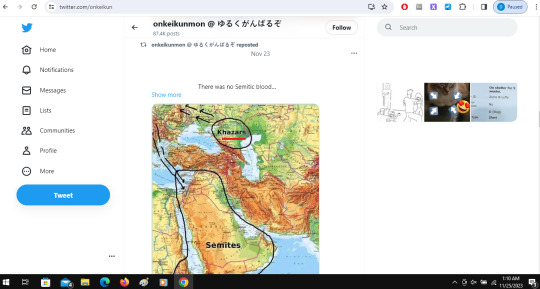
{Yeah, now it's the (anti-semitic propaganda) Khazar theory.}
#koushirouizumi posts#koushirouizumi advs#koushirouizumi digiadvs#koushirouizumi 02#great blaster#onkeikunmon#onkei kun#(IM GODDAMN TIRED)#(WHY IS NO ONE ELSE SAYING ANYTHING)#(For lack of better ref I'm linking to that one)#('largely ABANDONED hypothesis that postulated that Ashkenazim were primarily or to a large extent descended from Khazars')#(????? IT SAYS ALL OVER THE ARTICLE?????)#(Am I just expected to IGNORE that an officially affiliated account is lrtng all this?!??!!)
0 notes
Text
Some antisemitic dog whistles to watch out for
Because overtly hostile antisemitism is difficult to sell to people, and because it often gets people banned from media platforms, conspiracy theorists rely on other terms to get their ideas across.
Note that people will sometimes use these terms without understanding their connections to far right conspiracy theories, and some of them have legitimate uses outside of far right conspiracy theories. Don't assume that everyone who uses them is a secret Nazi or something. However, do pay close attention to what else they're saying and who they're getting their info from.
Banker/International banker: references the conspiracy theory that Jews control the banks.
Cabal/Kabbalists: references the belief that the Jewish conspirators are into Kabbalah (which is sometimes claimed to be satanic).
Globalists: references the conspiracy theory that Jews are working to create a one world order.
Talmudists: Literally just means Jews.
Marxists/Cultural Marxists: references the conspiracy theory that Jews created communism.
Leftists: references the conspiracy theory that progressive/leftist politics are a Jewish conspiracy.
The elite/elite bloodlines: references the conspiracy theory that most wealthy/ruling families have Jewish blood.
Khazars/Khazarian mafia: references a debunked hypothesis-turned-conspiracy theory that Ashkenazi Jews are descended from a group of Khazars who converted to Judaism. (Conspiracy theorists often claim that this means Ashkenazi Jews aren't "real" Jews - which is nonsense from every angle because Judaism does not measure Jewishness through genetics.)
Generational Satanists: references the 13 Illuminati bloodlines conspiracy theory, which is basically a knockoff of the material in The Protocols of the Learned Elders of Zion combined with blood libel and the anti-Catholic conspiracy theories of Alexander Hislop. Conspiracy theorists often claim that it isn't about Jews, it's about powerful families who sometimes just happen to be Jews, but like... c'mon, it's an obvious Protocols/blood libel knockoff that also happens to demonize a few more people. You're not slick.
Lizard people: references David Icke's assertion that the world is under the control of blood-drinking reptilian aliens who created Judaism to enslave humanity. Some people literally believe in Icke's lizard aliens; some just use the term as a dog whistle for regular Jews.
1K notes
·
View notes
Text
i know the khazar hypothesis isn't true, ashkenazim aren't actually descended from eurasian steppe nomads, but i think it's time to right the wrongs of the past. it's time for jews to take up horse archery
49 notes
·
View notes
Text
i cannot imagine anyone reading "the invention of the jewish people" by shlomo sand and coming to the conclusion that defining jews as an ethnic group is 'nazi bullshit' . that is such a simplistic and borderline antisemitic take on a very well constructed criticism on israel as an ethnostate. and yeah the khazar hypothesis is almost entirely bullshit but it is such a bad faith reading of a very important book it makes me sad and angry at the same time. not to mention who gave you the authority to make such a judgment on jewish people ?
10 notes
·
View notes
Text
I have long said that, if Ashkenazi Jews in the Russian Empire mixed with anyone, it was not with Slavs or Turks, but with other, preexisting Jewish communities like these proto-Romaniotim, or with Persian Jews who had migrated north through the Caucasus.
The Khazar hypothesis is utterly wrong, no matter how much antisemites cling to it in order to delegitimize Jewish identity and our connection to Eretz Yisrael.
2 notes
·
View notes
Text
RationalWiki correctly refers to the "Khazar" nonsense as "Khazar myth". Wikipedia says "Khazar hypothesis of Ashkenazi ancestry". While Wikipedia does report facts to discredit it, it presents contrarian viewpoints at all possible times.
It goes to show, mixing bullshit with reality does not make something NPOV.
Friendly reminder that you simply cannot use wikipedia as a reference for anything having to do with jews, judaism, israel, etc etc
661 notes
·
View notes
Text
my relationship with the israel palestine conflict is complex, i consider myself an antizionist but i generally stay out of the conversation because many people care far more about that geopolitical issue than me
im more interested in other things like the plight of the muslims (and to some extent sikhs) in india or the muslims and inner mongolians in china, zainichi koreans in japan etc. those are all issues i personally feel more strongly about
but i am in an israel palestine server and i argued w/ a few zionists about whether or not most israelis are colonizers and my contention was always "even if they lived there thousands of years ago i just don't believe that we have some sort of magical genetic claim to land in our DNA, i don't think you can just come back to these places our ancestors came from and take land and say you're not colonizing"
and they both came at me trying to like. disprove the khazar hypothesis? and other such insane antisemitic conspiracies that i never once mentioned
and i was like dude wtf are you guys talking about why are you trying to disprove these schizoid conspiracies to me when i never once mentioned them
like they couldn't grasp my actual argument, which is that the state of israel relies on a sort of superstitious magical thinking (we came from here once and so we always have a claim to this land because something something genetics and a magic book from 3000 years ago). like they just couldn't get it lol
we ended up being friends once they finally understood my actual position tho, well one of them anyways. the other one is still too insane
1 note
·
View note
Text
Khazar hypothesis of Ashkenazi ancestry - Wikipedia
https://en.m.wikipedia.org/wiki/Khazar_hypothesis_of_Ashkenazi_ancestry
0 notes
Text
🧐 Khazarian Hypothesis 🤔

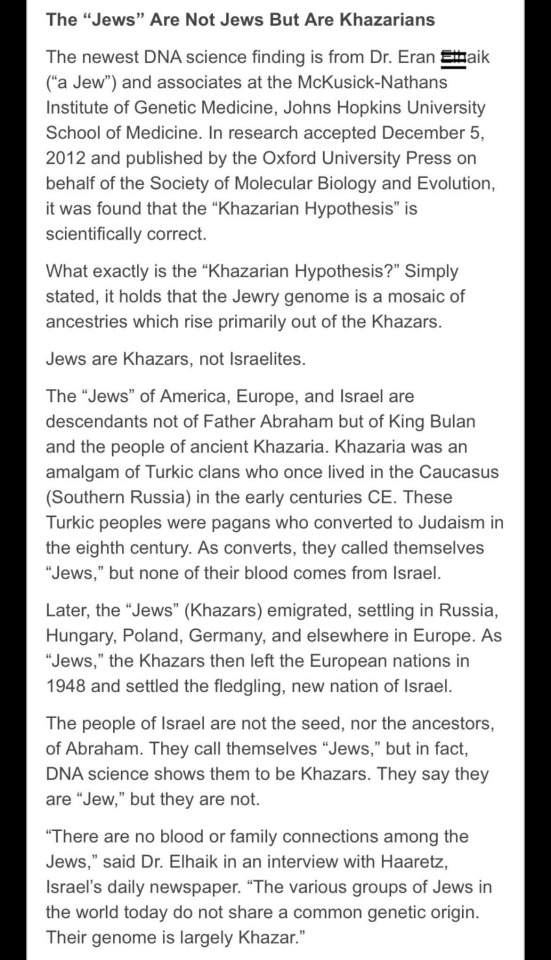



5 notes
·
View notes
Note
excuse my ignorance, but I just saw that ask in passing and if you are able to explain, what is the khazar theory?
1 note
·
View note
Text
The ubiquity of the Khazar hypothesis among anti-Zionists makes it very hard to deny their movement’s antisemitism.
They may deny it, but only because they reject the premise that Jews are Semitic.
1 note
·
View note
Text
debunking an antisemitic conspiracy theory re: ukraine
I spent most of my waking hours so far today in a professional development session for AP Psychology teachers. On breaks and over my lunch I was messaging back and forth on here with a conspiracy theorist about whom I was familiar, but with whom I'd never had any contact.
I was accused, in her words, of "lumping all Ukrainians together." She cited what I clocked as a conspiracy theory before I even realized that I knew her username from anti-conspiracist posts in another fandom.
So, I figured, if this is getting sent to me unsolicited, it's likely going to pop up elsewhere so I'll spend some time debunking it. This debunk is meant for reality-based readers. I am well-aware that the conspiracists do not give a fuck about facts.
The False Claim
"Khazars control over 85% of the government since the 2014 coup [sic], ruling over the ethnic majority, the Rus, who are oppressed. don't lump all Ukrainians [Khazars and Rus] together!"
The Facts
I will begin with reminding everyone that ethnicity is not as clear-cut as you might imagine. We are all familiar with products like 23andme and AncestryDNA. I submitted a sample to AncestryDNA years ago to better understand where my ancestors came from. According to the ever-more-'exact' results, I am as western European as anyone could be. But ... do genetics tell us our ethnicity? Not really! Ethnicity is about social groups and those aren't in DNA. What AncestryDNA tells me is where people who have DNA similar to mine are from, and from that we can make assumptions about the social groups and cultures they may have had, if we know when my ancestors would have left there. (For one branch of my family I do know this. For others, I do not.)
So ... do people who live in Ukraine know their genetic ethnicity (the only reason to be bringing up Khazars and Rus)? Maybe some do! Maybe some don't, but this is not a topic that seems to be top-of-mind for the people of Ukraine at this moment. Why do I say that? Well, if the false claim of the conspiracy theorist were true, someone other than Vladimir Putin and his state-run media would be crying about genocides that aren't happening. And you know what else? Putin would be using these terms - Khazar and Rus. Alas, he isn't. Putin focuses on MUCH more recent history. His goal is to bring the Russian Empire back to its greatest extent (and pretending that it was never ruled by the Mongols).
Those who bring up the Khazars in this context believe that the Ashkenazi Jews descend from the Khazars, which would make their claims in the holy land not supportable. For what it's worth, genetic studies to not support the antisemitic hypothesis and anyone espousing this link is misinformed at best and engaging in conspiracism at worst. Here is an article about the myth and its debunking.
"But Soupy! Your conspiracist didn't say the Khazars are Jews!"
You're correct, she did not. However, she did say that these Khazars control the government and are oppressing the non-Khazar "majority." This is an antisemitic trope, that Jews are in control of major institutions and using that control to oppress others. Furthermore, the president of Ukraine, Volodymyr Zelenskyy, is Jewish. Her antisemitic claim is very thinly veiled.
Later in our bizarre conversation, after I called out this antisemitism, this conspiracist cited a rabbi who supports this theory, and so it cannot be antisemitic. Leaving aside the bad logic there, the rabbi she cited was Marvin Stuart Antelman. His book To eliminate the opiate appears in a collection of books and pamphlets deemed by the Judaica Library at University of Florida to be antisemitic. Interestingly, also on that list is a book Is there a difference between a Khazar Jew and a Palestinian Jew? I can only guess at the answer.
Ethnic conflict is not the primary conflict in Ukraine. Conspiracists like the one barging into my messages this morning like to point to the census information from the Donbas region, where a majority (~78% in 2001) of the residents are native Russian speakers. But they decline to take note that these native Russian speakers are not all claiming Russian ethnicity -- 60% of the residents of Donbas in 2001 (largely the same number as the late 1920s) claimed Ukrainian ethnicity.
The fact is, these conspiracists are falling victim to Russian propaganda, plain and simple. Putin has told his country that Ukraine is Russia, that the people of Ukraine will welcome the Russian military with flowers because they are oppressed by this illegitimate [sic] government. The facts on the ground PROVE this is not the case. If Putin were right, why has Kyiv still not fallen*? Why is Kharkiv, closer to Russia, still controlled by Ukrainians? How is Zelenskyy still alive? If the "Khazars" are the minority in this country, and the majority "Rus" want them gone, wouldn't the Rus fight on the side of the Russian military?
As with every conspiracy theory, this one doesn't hold up against the facts.
*I am posting this at 4:31pm CST on 26 February 2022
#ukraine#russia#khazar#rus#conspiracy theory#antisemitism#all conspiracy theories are the same#all conspiracy theorists are the same
42 notes
·
View notes
Text
“Putin himself seems to mention how Zelensky is a “Jew by nationality” — a very peculiar formulation.
Left unsaid is how Putin clearly sees Ukraine as a fake country — he has said it before — and a fake people with a Jewish leader. He sees them as a part of Khazaria.”
.
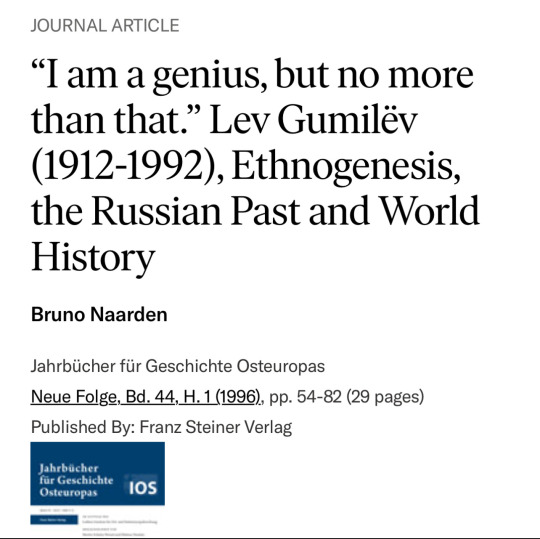
youtube
2 notes
·
View notes
Text
Russian Fairy Tales Test Prep: Pagan Deities
The best known roster of pagan deities is that of the six whose statues Prince Vladimir erected upon assuming sole rule of Kiev. According to the Primary Chronicle for the year 980, he “placed idols on a hill, outside the palace yard, a wooden Perun with a silver head and a golden mustache, and Khors and Dazhbog and Stribog and Simargl and Mokosh.” Missing from this list is Volos/Veles, the god of cattle (skotnii bog) and commerce, whose veneration in ancient Rus’ is widely attested, and by whose name (along with that of Perun) ancient Russians ratified oaths.
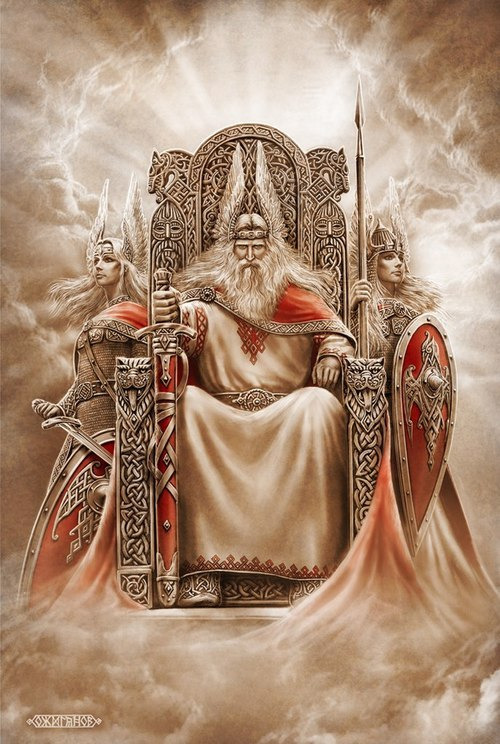
A. Perun/Bog
1. equivalent to: Lithuanian Perkunas, Latvian Perkons, Albanian Perendi, Roman Jupiter, Greek Zeus, Hittite Teshub, Norse Thor/Donar, Celtic Taranis. 2. primary sources: Nestor’s Chronicle, mid-6th century Procopius, 10th-century Varangian treaties 3. primary story: a creation myth, in which he battles Veles, the Slavic god of the underworld, for the protection of his wife (Mokosh, goddess of summer) and the freedom of atmospheric water, as well as for the control of the universe. 4. dvoeverie: After Christianization in the 11th century CE, Perun's cult became associated with St. Elias (Elijah), also known as the Holy Prophet Ilie (or Ilija Muromets or Ilja Gromovik), who is said to have ridden madly with a chariot of fire across the sky, and punished his enemies with lightning bolts.
In Slavic mythology: Perun was the supreme god of the pre-Christian Slavic pantheon, although there is evidence that he supplanted Svarog (the god of the sun) as the leader at some point in history. Perun was a pagan warrior of heaven and patron protector of warriors. As the liberator of atmospheric water (through his creation tale battle with the dragon Veles), he was worshipped as a god of agriculture, and bulls and a few humans were sacrificed to him. In 988, the leader of the Kievan Rus' Vladimir I pulled down Perun's statue near Kyiv (Ukraine) and it was cast into the waters of the Dneiper River. As recently as 1950, people would cast gold coins in the Dneiper to honor Perun.
Appearance & Reputation: Perun is portrayed as a vigorous, red-bearded man with an imposing stature, with silver hair and a golden mustache. He carries a hammer, a war ax, and/or a bow with which he shoots bolts of lightning. He is associated with oxen and represented by a sacred tree—a mighty oak. He is sometimes illustrated as riding through the sky in a chariot drawn by a goat. In illustrations of his primary myth, he is sometimes pictured as an eagle sitting in the top branches of the tree, with his enemy and battle rival Veles the dragon curled around its roots.
Perun is associated with Thursday—the Slavic word for Thursday "Perendan" means "Perun's Day"—and his festival date was June 21.
Reports: The earliest reference to Perun is in the works of the Byzantine scholar Procopius (500–565 CE), who noted that the Slavs worshipped the "Maker of Lightning" as the lord over everything and the god to whom cattle and other victims were sacrificed.
Perun appears in several surviving Varangian (Rus) treaties beginning in 907 CE. In 945, a treaty between the Rus' leader Prince Igor (consort of Princess Olga) and the Byzantine emperor Constantine VII included a reference to Igor's men (the unbaptized ones) laying down their weapons, shields, and gold ornaments and taking an oath at a statue of Perun—the baptized ones worshipped at the nearby church of St. Elias. The Chronicle of Novgorod (compiled 1016–1471) reports that when the Perun shrine in that city was attacked, there was a serious uprising of the people, all suggesting that the myth had some long-term substance.
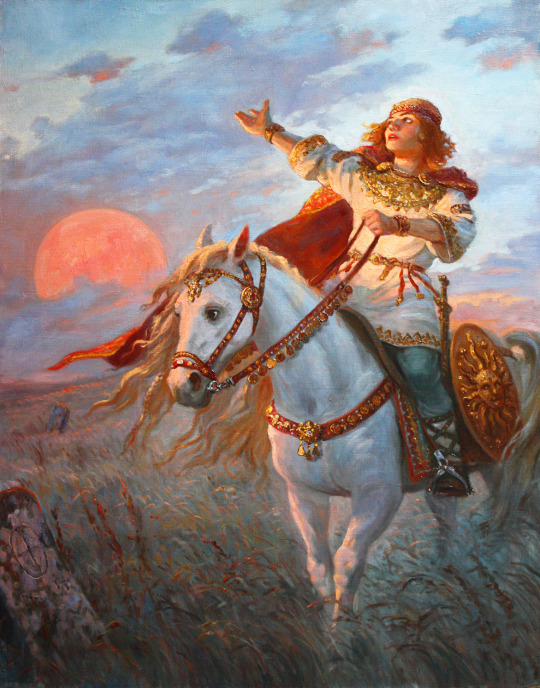
B. Kors/Xors/Chors
- most frequently mentioned Slavic god, after Perun - dvoeverie: appears in the apocryphal work Sermon and Apocalypse of the Holy Apostles, which mentions Perun and Khors as old men; Khors is said to live in Cyprus. Khors also appears in the apocryphal text Conversation of the Three Saints, a text which combines Slavic + Christian + Bogomil traditions. In it, he is referred to as “an angel of thunder” and it is said that he is Jewish. - his functions are uncertain and there are multiple interpretations of his name.
1. Sun God hypothesis: associated with Dazhbog; in The Tale of Igor’s Campaign, Prince Vseslav, who “came to Tmutarakani before the cocks" and "Khors ran his way", traveled from west to east and thus reached the castle before the cocks crowed, and in this way "overtook" the Sun; his name means “rays.”
2. Moon God hypothesis: Prince Vseslav was called “wolf” and his journey takes place at night when the sun is absent from the sky; his name does mean “rays” but they’re the moon’s rays and not the sun’s rays.
3. Fertility God/Vegetation hypothesis: link between Thracian & early Slavic cultures indicates Kors is more of a Dionysus-type figure, who dies and is risen; like Dionysus, Dazhbog (who Kors is often linked to) has a double nature (Eastern Slavs assign him solar qualities, while Southern Slavs assign him chthonic qualities).
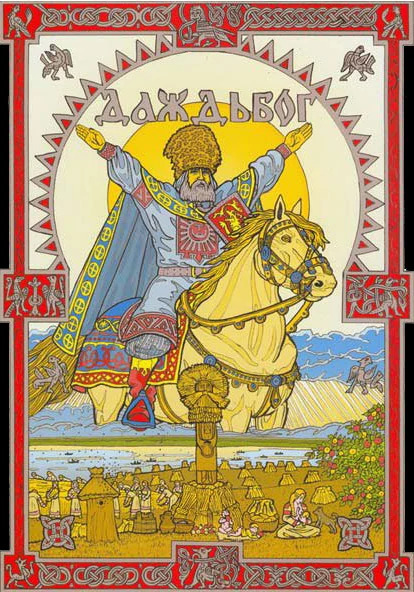
C. Dazhbog
1. equivalent to: Khors (Russian/Iranian), Mithra (Persian), Helios (Greek), Lucifer (Christian) 2. primary sources: John Malalas, The Song of Igor’s Campaign 3. family: Son of Svarog, brother of fire god Svarozhich, husband of Mesyats (the moon), father of the Zoryi and Zvezdy 4. primary myth: He resided in the east, in a land of everlasting summer and plenty, in a palace made of gold. The morning and evening auroras, known collectively as Zorya, were his daughters. In the morning, Zorya opened the palace gates to allow Dazbog to leave the palace and begin his daily journey across the sky; in the evening, Zorya closed the gates after the sun returned in the evening. 5. dvoeverie: There was a belief that each winter he would enter people's homes and gift gold to those who had been good. That belief passed into Christianity, especially in Serbia, and this visitor was called Položajnik. During Christianisation, his cult was exchanged with the cult of Saint Sava, while Dažbog became lame Daba - the most powerful demon in Hell. Reasons why he was demonized are various, possibly because his cult was the strongest in Serbia or because he was considered also as the god of Nav, the Slavic underworld and world of the dead.
In Slavic mythology: Dazbog was the Slavic sun god, a role that is common to many Indo-European people, and there is ample evidence that there was a sun cult in the pre-Christian tribes of central Europe. His name means "day god" or "giving god," to different scholars—"Bog" is generally accepted to mean "god," but Daz means either "day" or "giving."
His totem animal was a wolf, therefore wolves were sacred animals and killing them was considered a great sin. Wolves were considered to be messengers of Dazhbog, while he himself could shift into a white wolf.
According to one myth, Svarog became tired of reigning over the universe and passed on his power to his sons, Dazhbog and Svarogich.
Appearance & Reputation: Dazbog is said to ride across the sky in a golden chariot drawn by fire-breathing horses who are white, gold, silver, or diamonds. In some tales, the horses are beautiful and white with golden wings, and sunlight comes from the solar fire shield Dazbog always carries with him. At night, Dazbog wanders the sky from east to west, crossing the great ocean with a boat pulled by geese, wild ducks, and swans.
In some tales, Dazbog starts out in the morning as a young, strong man but by the evening he is a red-faced, bloated elderly gentleman; he is reborn every morning. He represents fertility, male power, and in "The Song of Igor's Campaign" he is mentioned as the grandfather of the Slavs.
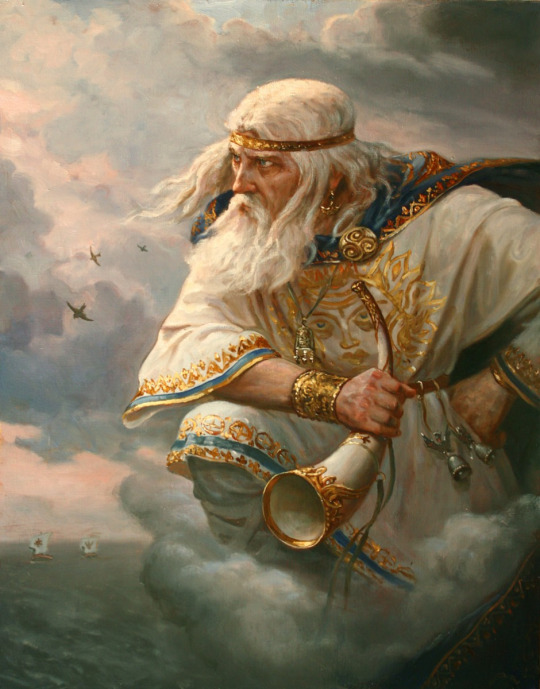
4. Stribog
Very little is known about him, although he was clearly very important to early Slavic peoples. In the epic ”Slovo o polku Igorove “ it is said that the winds, the grandsons of Stribog, blow from the sea. This leads to conclusion that Stribog is imagined as an old person, since he has grandsons. The grandsons were the winds from all directions.
Eagle was the animal consecrated to Stribog. Plants consecrated to Stribog were hawthorn and oak. When pledges were made, Stribog was often warrantor. Festivities in Stribog’s honor were organized in the summer as well as in the winter. They were probably organized in the summer in order to invocate winds and rain, while in the winter they were organized in order to appease him. In the period of Christianization Stribog’s characteristics were overtaken by St. Bartholomew and Stevan vetroviti (windy).
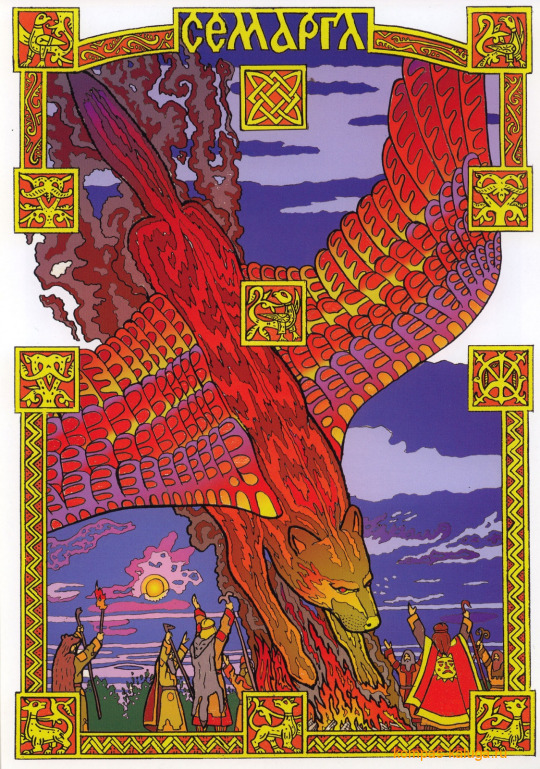
5. Simargl/Semargl
- may be equivalent to Simurgh in Persian mythology, who is portrayed similarly (winged lion and/or dog). He can also take human form. - God of physical fire (as opposed to celestial fire; that’s Svarog) - He is said to be the husband of Kupalnica (or Kupalnitsa), goddess of night, from whom he got two children: Kupalo and Kostroma.
Zorya, solar goddesses who are servants or daughters of the deity Dazhbog, keep Simargl chained to the star Polaris in the constellation Ursa Minor. Should he break free and destroy this constellation, it will cause the world to end.
Why would he be worshipped in Rus’, you ask? A couple of possible answers: a. Eastern Slavs borrowed Simargl from Sarmatian-Alanian people and worshiped him. b. Eastern Slavs never worshiped Simargl. Just at that time, a significant number of Kiev residents were of Khazar and Sarmatian-Alanian origin. Vladimir included their deity in the pantheon to get their support.

6. Volos/Veles (also Vlas, Weles Vlasii, St. Blaise, or Blasius)
1. equivalent to: Velinas (Baltic), Varuna (Vedic), Hermes (Greek), Odin (Norse) 2. primary sources: The Tale of Igor’s Campaign, old Russian chronicles 3. primary myth: a creation myth, in which Veles abducts Mokosh (the Goddess of Summer and consort of Perun, God of Thunder). Perun and his enemy battle for the universe under a huge oak, Perun's holy tree, similar to both Greek and Norse (Yggdrasil) mythologies. The battle is won by Perun, and afterward, the waters of the world are set free and flowing. 4. dvoeverie: Velia remains a feast of the dead in old Lithuanian, celebrating the border between the world of the living and the world of the dead, with Veles operating as a role of guiding souls to the underworld. The battle between Perun (Ilija Muromets or St. Elias) and Veles (Selevkiy) is found in many different forms, but in later stories, instead of gods, they are complementary figures separated from one another by a furrow plowed by Christ, who converts them. Veles is also likely represented by St. Vlasii, depicted in Russian iconography as surrounded by sheep, cows, and goats.
In Slavic mythology: A second creation myth associated with Veles is the formation of the boundary between the underworld and the human world, a result of a treaty forged between Veles and a shepherd/magician.
In the treaty, the unnamed shepherd pledges to sacrifice his best cow to Veles and keep many prohibitions. Then he divides the human world from the wild underworld led by Veles, which is either a furrow plowed by Veles himself or a groove across the road carved by the shepherd with a knife which the evil powers cannot cross.
Veles is associated with a wide variety of powers and protectors: he is associated with poetry and wisdom, the lord of the waters (oceans, seas, ships, and whirlpools). He is both the hunter and protector of cattle and the lord of the underworld, a reflection of the Indo-European concept of the netherworld as a pasture. He is also related to an ancient Slavic cult of the deceased soul; the ancient Lithuanian term "welis" means "dead" and "welci" means "dead souls."
Appearance & Reputation: Veles is generally portrayed as a bald human man, sometimes with bull horns on his head. In the epic creation battle between Velos and Perun, however, Veles is a serpent or dragon lying in a nest of black wool or on a black fleece beneath the World Tree; some scholars have suggested he was a shape-shifter. In addition to domestic horses, cows, goats, and sheep, Veles is associated with wolves, reptiles, and black birds (ravens and crows).
Reports: The earliest reference to Veles is in the Rus-Byzantine Treaty of 971, in which the signers must swear by Veles' name. Violators of the treaty are warned of a menacing punishment: they will be killed by their own weapons and become "yellow as gold," which some scholars have interpreted as "cursed with a disease." If so, that would imply a connection to the Vedic god Varuna, also a cattle god who could send diseases to punish miscreants.
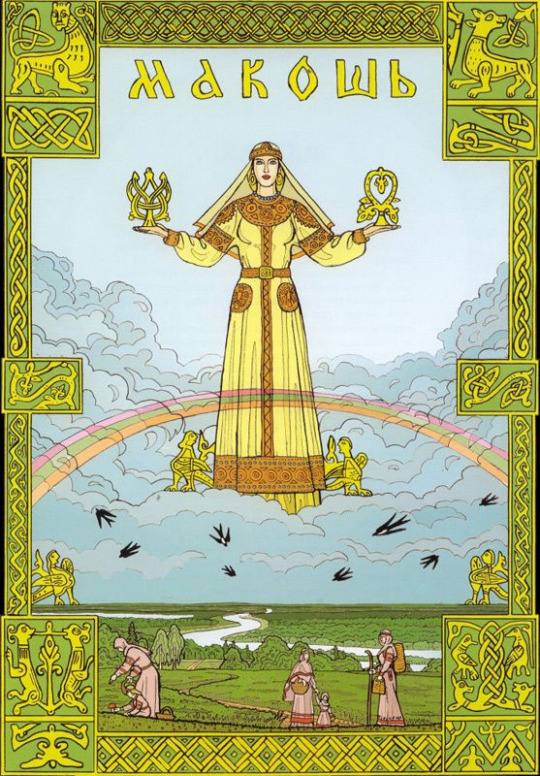
7. Mokosh
1. loosely comparable to: Gaia, Hera (Greek), Juno (Roman), Astarte (Semitic) 2. epithets: Goddess Who Spins Wool, Mother Moist Earth, Flax Woman 3. primary sources: Nestor Chronicle (a.k.a. Primary Chronicle), Christian-recorded Slavic tales 4. dvoeverie: With the coming of Christianity into the Slavic countries in the 11th century CE, Mokosh was converted to a saint, St. Paraskeva Pyanitsa (or possibly the Virgin Mary), who is sometimes defined as the personification of the day of Christ's crucifixion, and others a Christian martyr. Described as tall and thin with loose hair, St. Paraskeva Pyanitsa is known as "l'nianisa" (flax woman), connecting her to spinning. She is the patroness of merchants and traders and marriage, and she defends her followers from a range of diseases.
In Slavic mythology: The origins of Mokosh as mother earth may date to pre-Indo-European times (Cuceteni or Tripolye culture, 6th–5th millennia BCE) when a near-global woman-centered religion is thought to have been in place. Some scholars suggest she may be a version of Finno-Ugric sun goddess Jumala.
Mokosh, sometimes transliterated as Mokoš and meaning "Friday," is Moist Mother Earth and thus the most important (or sometimes only) goddess in the religion. As a creator, she is said to have been discovered sleeping in a cave by a flowering spring by the spring god Jarilo, with whom she created the fruits of the earth. She is also the protector of spinning, tending sheep, and wool, patron of merchants and fishermen, who protects cattle from plague and people from drought, disease, drowning, and unclean spirits.
Although the Great Goddess has a variety of consorts, both human and animal, in her role as a primary Slavic goddess, Mokosh is the moist earth goddess and is set against (and married to) Perun as the dry sky god. Some Slavic peasants felt it was wrong to spit on the earth or beat it. During the Spring, practitioners considered the earth pregnant: before March 25 ("Lady Day"), they would neither construct a building or a fence, drive a stake into the ground or sow seed. When peasant women gathered herbs they first lay prone and prayed to Mother Earth to bless any medicinal herbs.
Appearance & Reputation: Surviving images of Mokosh are rare—although there were stone monuments to her beginning at least as long ago as the 7th century. A wooden cult figure in a wooded area in the Czech Republic is said to be a figure of her. Historical references say she had a large head and long arms, a reference to her connection with spiders and spinning. Symbols associated with her include spindles and cloth, the rhombus (a nearly global reference to women's genitals for at least 20,000 years), and the Sacred Tree or Pillar.There are many goddesses in the various Indo-European pantheons who reference spiders and spinning. Historian Mary Kilbourne Matossian has pointed out that the Latin word for tissue "textere" means "to weave," and in several derivative languages such as Old French, "tissue" means "something woven." The act of spinning, suggests Matossian, is to create body tissue. The umbilical cord is the thread of life, transmitting moisture from the mother to the infant, twisted and coiled like the thread around a spindle. The final cloth of life is represented by the shroud or "winding sheet," wrapped around a corpse in a spiral, as thread loops around a spindle.
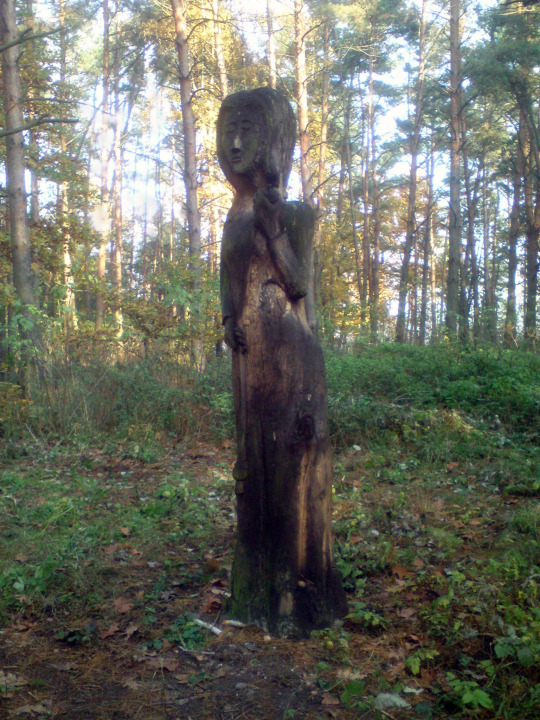
Our brief survey of agrarian holidays indicates that the peasant’s central concern is fertility and that special rites in the cemetery and/or rites involving a symbolic death & resurrection are a major component in these celebrations.
Belief in the absolute sanctity of “Mother Damp Earth” (Mat’syra zemlia) has been central to folk belief throughout the centuries. In remote areas, old people observed a ritual of asking the earth’s forgiveness prior to death into the 20th century. A number of scholars have maintained that peasants transferred attributes of earth worship to their particular veneration of Mary as “Mother of God.”
Fedotov: “At every step in studying Russian popular religion, one meets the constant longing for a great divine female power, be it embodied in the image of Mary or someone else. Is it too daring to hypothesize, on the basis of this religious propensity, the scattered elements of the cult of a Great Goddess who once...reigned upon the immense Russian plains?”
#Russian fairy tales#study blog#my notes#Slavic deities#slavic mythology#Russian paganism#russian folk belief
124 notes
·
View notes